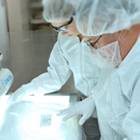BIOSS INC
Artikel-Nr:
(BOSSBS-12148R)
Lieferant:
Bioss
Hersteller-Artikelnummer::
BS-12148R
Lokale Artikelnummer::
BOSSBS-12148R
Beschreibung:
Transcription repressor. Required for the specification of corticospinal motor neurons and other subcerebral projection neurons. May play a role in layer and neuronal subtype-specific patterning of subcortical projections and axonal fasciculation. Controls the development of dendritic arborization and spines of large layer V pyramidal neurons. May be involved in innate immunity (By similarity).
VE:
1 * 100 µl
Artikel-Nr:
(BOSSBS-12147R)
Lieferant:
Bioss
Hersteller-Artikelnummer::
BS-12147R
Lokale Artikelnummer::
BOSSBS-12147R
Beschreibung:
Zic5 (zinc finger protein of the cerebellum 5) is a C2H2 zinc finger transcription factor that influences development of the neural crest. Zic family members are abundant in developing and adult cerebellum. Zic family members are important during development, and have been associated with X-linked visceral heterotaxy and holoprosencephaly type 5. Zic5 is closely linked to Zic2, a related family member on chromosome 13.
VE:
1 * 100 µl
Artikel-Nr:
(BOSSBS-7097R)
Lieferant:
Bioss
Hersteller-Artikelnummer::
BS-7097R
Lokale Artikelnummer::
BOSSBS-7097R
Beschreibung:
May be required for normal outer mitochondrial membrane dynamics. Required for coatomer-mediated retrograde transport in certain cells. May recruit other proteins to membranes with high curvature. May promote membrane fusion.Tissue specificity: Highly expressed in heart, skeletal muscle, kidney and placenta. Detected at lower levels in brain, colon, thymus, spleen, liver, small intestine, lung and peripheral blood leukocytes.
VE:
1 * 100 µl
Artikel-Nr:
(BOSSBS-7083R)
Lieferant:
Bioss
Hersteller-Artikelnummer::
BS-7083R
Lokale Artikelnummer::
BOSSBS-7083R
Beschreibung:
The protein encoded by this gene belongs to the membrane-associated guanylate kinase (MAGUK) family, a class of proteins that functions as molecular scaffolds for the assembly of multiprotein complexes at specialized regions of the plasma membrane. This protein is also a member of the CARD protein family, which is defined by carrying a characteristic caspase-associated recruitment domain (CARD). This protein shares a similar domain structure with CARD11 protein. The CARD domains of both proteins have been shown to specifically interact with BCL10, a protein known to function as a positive regulator of cell apoptosis and NF-kappaB activation. When expressed in cells, this protein activated NF-kappaB and induced the phosphorylation of BCL10. Two alternatively spliced variants of this gene encoding distinct isoforms have been reported.
VE:
1 * 100 µl
Artikel-Nr:
(BOSSBS-8226R)
Lieferant:
Bioss
Hersteller-Artikelnummer::
BS-8226R
Lokale Artikelnummer::
BOSSBS-8226R
Beschreibung:
FAM161B is a 647 amino acid protein that belongs to the FAM161 family. The gene that encodes FAM161B consists of approximately 16,413 bases and maps to human chromosome 14q24.3. Housing over 700 genes, chromosome 14 comprises nearly 3.5% of the human genome. Chromosome 14 encodes the Presenilin 1 (PSEN1) gene, which is one of the three key genes associated with the development of Alzheimer’s disease. The SERPINA1 gene is also located on chromosome 14 and, when defective, leads to the genetic disorder α1-antitrypsin deficiency, which is characterized by severe lung complications and liver dysfunction. An inversion of the long arm of chromosome 14 is thought to be involved in T-cell chronic lymphocytic leukemia (CLL), a cancer that affects T lymphocytes.
VE:
1 * 100 µl
Artikel-Nr:
(BOSSBS-7098R)
Lieferant:
Bioss
Hersteller-Artikelnummer::
BS-7098R
Lokale Artikelnummer::
BOSSBS-7098R
Beschreibung:
Can insert into membranes and form poorly selective ion channels that may also transport chloride ions. Channel activity depends on the pH. Membrane insertion seems to be redox-regulated and may occur only under oxydizing conditions. Promotes cell-surface expression of HRH3. Has alternate cellular functions like a potential role in angiogenesis or in maintaining apical-basolateral membrane polarity during mitosis and cytokinesis. Could also promote endothelial cell proliferation and regulate endothelial morphogenesis.Tissue specificity: Detected in epithelial cells from colon, esophagus and kidney (at protein level). Expression is prominent in heart, kidney, placenta and skeletal muscle.
VE:
1 * 100 µl
Artikel-Nr:
(BOSSBS-8165R)
Lieferant:
Bioss
Hersteller-Artikelnummer::
BS-8165R
Lokale Artikelnummer::
BOSSBS-8165R
Beschreibung:
Plays a role as a modulator of TGF-beta-signaling by restricting substrate specificity of RNF111. Involved in autophagy. Regulates early events but also late events of autophagosome formation through direct interaction with Atg16L1. Required for the formation of the autophagosome-like double-membrane structure that surrounds the Salmonella-containing vacuole (SCV) duting S.typhimurium infection and subsequent xenophagy. Autophagy positively regulates repair of DNA damage induced by ionizing radiation and negatively regulates apoptosis. Plays an indispensible role in fetal hematopoiesis and in the regulation of neuronal homeostasis (By similarity). Implicated in the regulation of RB1 expression. Functions as a DNA-binding transcription factor. Is a potent regulator of the RB1 pathway and a mediator that plays a crucial role in muscular differentiation. Expression is, thus, a prerequisite for myogenic differentiation. Inhibits PTK2/FAK1 and PTK2B/PYK2 activity and activation of downstream signaling pathways.
VE:
1 * 100 µl
Artikel-Nr:
(BOSSBS-7056R)
Lieferant:
Bioss
Hersteller-Artikelnummer::
BS-7056R
Lokale Artikelnummer::
BOSSBS-7056R
Beschreibung:
Dioxygenase that repairs alkylated DNA and RNA by oxidative demethylation. Has highest activity towards single-stranded RNA containing 3-methyluracil, followed by single-stranded DNA containing 3-methylthymine. Has low demethylase activity towards single-stranded DNA containing 1-methyladenine or 3-methylcytosine. Specifically demethylates N(6)-methyladenosine (m6A) RNA, the most prevalent internal modification of messenger RNA (mRNA) in higher eukaryotes. Has no activity towards 1-methylguanine. Has no detectable activity towards double-stranded DNA. Requires molecular oxygen, alpha-ketoglutarate and iron. Contributes to the regulation of the global metabolic rate, energy expenditure and energy homeostasis. Contributes to the regulation of body size and body fat accumulation.
VE:
1 * 100 µl
Artikel-Nr:
(BOSSBS-8161R)
Lieferant:
Bioss
Hersteller-Artikelnummer::
BS-8161R
Lokale Artikelnummer::
BOSSBS-8161R
Beschreibung:
Subunit of both mTORC1 and mTORC2, which regulates cell growth and survival in response to nutrient and hormonal signals. mTORC1 is activated in response to growth factors or amino-acids. Growth factor-stimulated mTORC1 activation involves a AKT1-mediated phosphorylation of TSC1-TSC2, which leads to the activation of the RHEB GTPase that potently activates the protein kinase activity of mTORC1. Amino-acid-signaling to mTORC1 requires its relocalization to the lysosomes mediated by the Ragulator complex and the Rag GTPases. Activated mTORC1 up-regulates protein synthesis by phosphorylating key regulators of mRNA translation and ribosome synthesis. mTORC1 phosphorylates EIF4EBP1 and releases it from inhibiting the elongation initiation factor 4E (eiF4E). mTORC1 phosphorylates and activates S6K1 at 'Thr-389', which then promotes protein synthesis by phosphorylating PDCD4 and targeting it for degradation.Tissue specificity:Broadly expressed, with highest levels in skeletal muscle, heart and kidney.
VE:
1 * 100 µl
Artikel-Nr:
(BOSSBS-13531R)
Lieferant:
Bioss
Hersteller-Artikelnummer::
BS-13531R
Lokale Artikelnummer::
BOSSBS-13531R
Beschreibung:
GPR32 (probable G-protein coupled receptor 32) is a 356 amino acid member of the G protein-coupled receptor 1 family. Localized to the cell membrane, GPR32 is an orphan receptor. The gene that encodes GPR32 maps to human chromosome 19q13.33. Human chromosome 19 consists of around 63 million bases with over 1,400 genes, making up over 2% of human genomic DNA. Chromosome 19 includes a diversity of interesting genes and is recognized for having the greatest gene density of the human chromosomes. It is the genetic home for a number of immunoglobulin superfamily members including the killer cell and leukocyte Ig-like receptors, a number of ICAMs, the CEACAM and PSG family, and Fc alpha receptors.
VE:
1 * 100 µl
Artikel-Nr:
(BOSSBS-2064R)
Lieferant:
Bioss
Hersteller-Artikelnummer::
BS-2064R
Lokale Artikelnummer::
BOSSBS-2064R
Beschreibung:
Bovine beta-lactoglobulin is the content of the milk in the category of a protein myosin. Protein contained in whole milk (3.7 percent) to 80% of the casein in the removal of the casein whey protein, 55% of the beta-lactoglobulin. Access to the crystallization of the isoelectric point = 5.2, the pH in this dual capacity under the main structure. The people in latex-free Beta-lactoglobulin. The beta-lactoglobulin and bov beta-lactoglobulinA-based.
VE:
1 * 100 µl
Artikel-Nr:
(BOSSBS-13527R)
Lieferant:
Bioss
Hersteller-Artikelnummer::
BS-13527R
Lokale Artikelnummer::
BOSSBS-13527R
Beschreibung:
G protein-coupled receptors (GPRs) are a protein family of transmembrane receptors that transmit an extracellular signal (ligand binding) into an intracellular signal (G protein activation). GPR signaling is an ancient evolutionarily mechanism used by all eukaryotes to sense environmental stimuli and mediate cell-cell communication. GPRs have seven membrane-spanning domains and the extracellular domains are often glycosylated. These extracellular loops also contain two highly conserved cysteine residues which create disulfide bonds to stabilize the receptor structure. GPR26 (G-protein coupled receptor 26) is a 337 amino acid protein that is primarily expressed in regions of the brain. GPR26 is characterized as an ‘orphan’ G protein-coupled receptor, which is a receptor that binds an unidentified natural ligand. Due to evidence of GPR26 being downregulated in glioblastomas, it has been suggested that GPR26 may be a suppressor of early glioma development.
VE:
1 * 100 µl
Artikel-Nr:
(BOSSBS-2115R)
Lieferant:
Bioss
Hersteller-Artikelnummer::
BS-2115R
Lokale Artikelnummer::
BOSSBS-2115R
Beschreibung:
Glu-Glu Tag is a commonly used epitope tag engineered onto the N- or C- terminus of a protein of interest so that the tagged protein can be analyzed and visualized.Because of the small size of the epitope, it is unlikely to alter the activity of the cloned sequence.
VE:
1 * 100 µl
Artikel-Nr:
(BOSSBS-13513R)
Lieferant:
Bioss
Hersteller-Artikelnummer::
BS-13513R
Lokale Artikelnummer::
BOSSBS-13513R
Beschreibung:
G protein-coupled receptors (GPRs), also known as seven transmembrane receptors, heptahelical receptors or 7TM receptors, comprise a superfamily of proteins that play a role in many different stimulus-response pathways. G protein coupled receptors translate extracellular signals into intracellular signals (G protein activation) and they respond to a variety of signaling molecules, such as hormones and neurotransmitters. GPR110 (G protein-coupled receptor 110), also known as PGR19, is a 911 amino acid protein that belongs to the G-protein coupled receptor 2 family and LN-TM7 subfamily. Characterized as an adhesion GPCR, GPR110 is a multipass membrane-bound protein with a long amino-terminus that contains multiple domains. One of these domains is the GPCR proteolytic site (GPS), which is essential for proteolytic cleavage of the amino-terminus and for cell surface expression.
VE:
1 * 100 µl
Artikel-Nr:
(BOSSBS-0807R)
Lieferant:
Bioss
Hersteller-Artikelnummer::
BS-0807R
Lokale Artikelnummer::
BOSSBS-0807R
Beschreibung:
Anti-Os05g0477200 protein Rabbit Polyclonal Antibody
VE:
1 * 100 µl
Artikel-Nr:
(BOSSBS-0897R)
Lieferant:
Bioss
Hersteller-Artikelnummer::
BS-0897R
Lokale Artikelnummer::
BOSSBS-0897R
Beschreibung:
FABP are thought to play a role in the intracellular transport of long-chain fatty acids and their acyl-CoA esters. FABP2 is probably involved in triglyceride-rich lipoprotein synthesis. Binds saturated long-chain fatty acids with a high affinity, but binds with a lower affinity to unsaturated long-chain fatty acids. FABP2 may also help maintain energy homeostasis by functioning as a lipid sensor.
VE:
1 * 100 µl
Preis auf Anfrage
Lager für diesen Artikel ist begrenzt, kann aber in einem Lagerhaus in Ihrer Nähe zur Verfügung. Bitte stellen Sie sicher, dass Sie in sind angemeldet auf dieser Seite, so dass verfügbare Bestand angezeigt werden können. Wenn das
Lager für diesen Artikel ist begrenzt, kann aber in einem Lagerhaus in Ihrer Nähe zur Verfügung. Bitte stellen Sie sicher, dass Sie in sind angemeldet auf dieser Seite, so dass verfügbare Bestand angezeigt werden können. Wenn das
Dieses Produkt kann nur an eine Lieferadresse versandt werden die über die entsprechende Lizenzen verfügt. Für weitere Hilfe bitte kontaktieren Sie Ihr VWR Vertriebszentrum.
-Additional Documentation May be needed to purchase this item. A VWR representative will contact you if needed.
Dieses Produkt wurde von Ihrer Organisation gesperrt. Bitte kontaktieren Sie Ihren Einkauf für weitere Informationen.
Dieses Produkt ist Ersatz für den von Ihnen gewünschten Artikel.
Dieses Produkt ist nicht mehr verfügbar. Bitte kontaktieren Sie den VWR Kundenservice.
|
|||||||||

















































